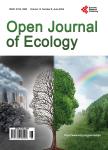An Ecological Assessment of Critically Endangered Chinese Pangolin <i>Manis pentadactyla</i>(Mammalia: Pholidota: Manidae) in the Midhills Region of Nepal
An Ecological Assessment of Critically Endangered Chinese Pangolin <i>Manis pentadactyla</i>(Mammalia: Pholidota: Manidae) in the Midhills Region of Nepal作者机构:Department of Environmental Science and Engineering Kathmandu University Dhulikhel Nepal Biodiversity Conservancy Nepal Butwal Nepal Department of Natural Resources Science University of Rhode Island Kingston RI USA
出 版 物:《Open Journal of Ecology》 (生态学期刊(英文))
年 卷 期:2021年第11卷第4期
页 面:344-356页
学科分类:0907[农学-林学] 08[工学] 0829[工学-林业工程] 09[农学]
主 题:Burrow Community Forest Conservation Density Habitat
摘 要:The Chinese Pangolin (Manis pentadactyla) is a “Critically Endangered insectivorous mammal. There is a lack of information on the ecology, distribution and behavior of this species in Nepal, even though community forests in the Midhills Region of Nepal are considered to be prime habitats for the species. We conducted an ecological assessment of the habitat use of this species in nine community forests covering an area of 170.69 ha in Balthali village in Kavrepalanchok district, Nepal. We divided each forest into 50 × 50 m grids and searched for Chinese Pangolin burrows along 50 m transects in each grid. We categorized burrows into two types, new and old burrows, and recorded 10 environmental variables for each burrow. We found a total of 542 burrows, including 323 old burrows and 219 new burrows. The average width and height of a burrow opening was 21.66 ± 3.94 cm (n = 542) and 22.42 ± 5.02 cm (n = 542). The total density of burrows in the study area was 3.1 ha−1, with new burrows density of 1.2 ha−1 and old burrows density of 1.8 ha−1. We found most burrows in sites with an elevation range of 1400 - 1500 m above sea level, gentle slopes, brown colored soil, high density of tree crown cover and undergrowth vegetation, southern exposure, within 150 m from a water source and less than 200 m from a human settlement. Our study has generated baseline data on the habitat use of Chinese Pangolin, which we hope will help in designing site-specific action plans for Chinese Pangolin conservation in Kavrepalanchok district, Nepal.



